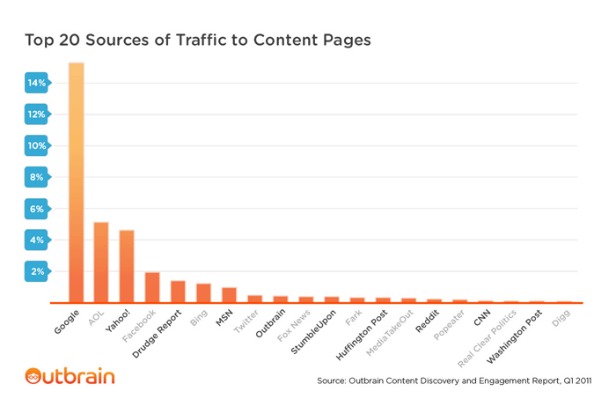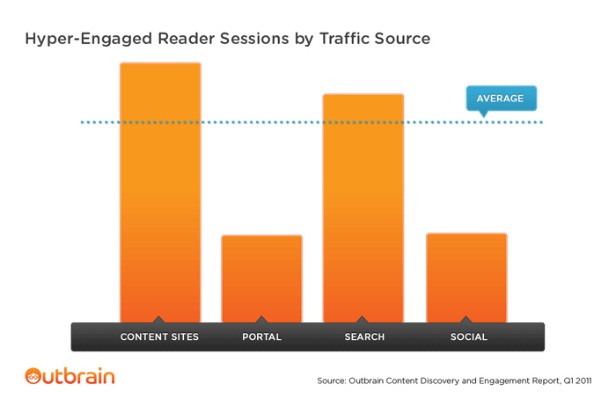Related link widget providers Outbrain have just released to their blog their first ever study of content discovery trends. How do people access content across the internet? While search still drives the majority of content discovery, social media is beginning to carve out its own chunk of the pie.
Outbrain is the top content recommendation service on the web. You can see their related link widgets on popular sites like USA Today, Slate, Newsweek and The Daily Beast. Their study is an analysis of Q1 2011 statistics of traffic patterns from publishers that are using their platform. They analyzed over 100 million sessions, which they define as a series of page views with no more than 30 minutes between one and the next.
They found that among traffic to content pages (articles and video), one-third of the sessions start from external sites. The other two-thirds come from directly accessing the site through type-ins, bookmarks and in-site links. So the data they analyzed comes from the 33% of sessions starting from external sites.
What they found was that the top three sources of traffic to content pages were Google, AOL and Yahoo respectively. Social networking sites Facebook and Twitter came in 4th and 8th, respectively. Digg rounded out the top 20.

In their breakdown of external sources for traffic, they found that search stills holds the largest chunk of the pie, at 41%. Content sites linking to other content sites made up 31%. Portal homepages accounted for 17% of directed traffic and social media sites hold 11%.
Search leading the way in content discovery should come as no surprise. The more interesting part of Outbrain’s study regards the types of information accessed via specific sources and “reader engagement” by category.
What type of content is being accessed through social media sites? Surprising or not, mostly news – 42% in fact. The next two top areas are entertainment stories with 30% and articles about lifestyle at 13%.

Reader engagement is highest when content is accessed through search or other content sites. Engagement is lowest when people come from social media sites – and inversely, the bounce rate (only one page view) is highest from social sites. Content sites have the lowest bounce rate, as Outbrain points out presumably because people accessing content via other content sites are already in content devouring mode.
Hyper-engaged readers, or what they call reader who access 5 or more pages per session, is also highest from content sites and search. As would be expected, readers coming in from social sites are not particularly hyper-engaged.

One last little tidbit that I found interesting:
Given the popularity of both Facebook and Twitter, we thought it was worth comparing their relative traffic quality to see what differences exist. Surprisingly, the two sites drive similarly engaged audiences in terms of page views per session, bounce rates and hyper-engaged reader sessions. The one key difference is in their relative reach, which we define as the number of unique visitors per 1,000 sessions. Specifically, we found about 72% of sessions originating from Facebook were from a unique visitor, versus only 52% in the case of Twitter, suggesting that Twitter’s audience is more likely to be made up of repeat visitors.
So, social site referrals are growing, but it looks like the challenge moving forward will be how to engage those readers past one page view. Obviously, a person jumping from content site to content site is in the mood to cram their brains with info – but people linked to a funny story via Facebook might not be in consumption mode. They are probably just curious. If these findings prove accurate, it will be especially important for news and entertainment companies to integrate fully into the social media sphere, as those are the types of stories most shared in that manner.